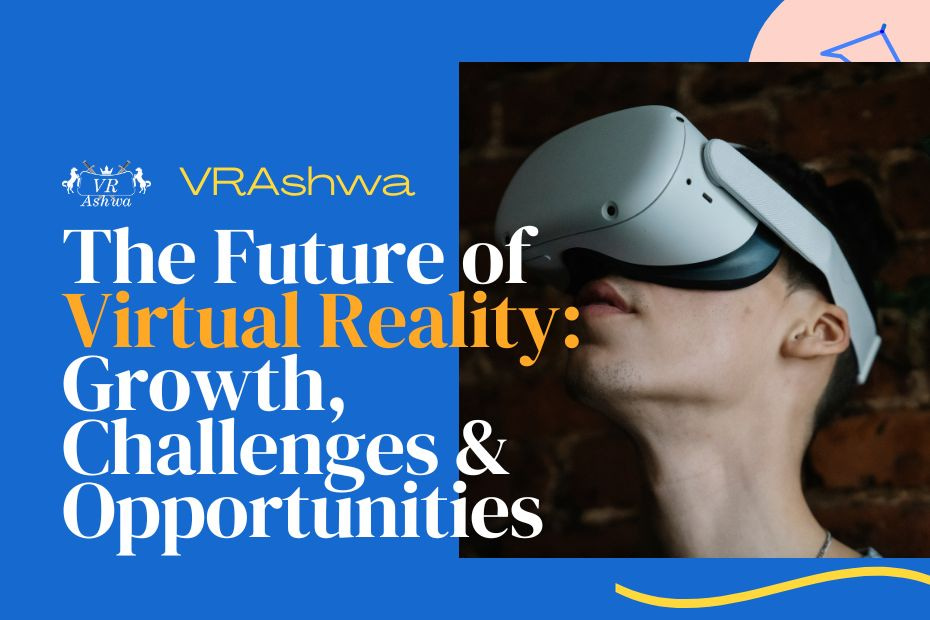Welcome to the wild and wonderful world of virtual reality! Strap on your VR headset, and let’s dive into the current state of the VR market.
2016 was a year of significant growth and innovation for the VR industry. From the launch of the Oculus Rift and the HTC Vive to the release of hit VR games like Batman: Arkham VR, the market has been heating up faster than a VR gamer’s palms.
And the numbers don’t lie: according to research by Deloitte, the VR market is expected to exceed $1 billion in revenue for the first time in 2016. That’s a lot of dough for a technology that was only recently a figment of our sci-fi imaginations.
But what does this all mean for the future? Well, it’s only the beginning. The VR market is still highly fragmented and unpredictable, but the growth potential is staggering as more content and hardware options emerge.
Think of it like the early days of the internet. Sure, we had AOL and dial-up modems, but who could have predicted the rise of social media, streaming services, and the almighty cat video? The same is true for VR – we’ve only scratched the surface of what’s possible.
So put on your VR headset and get ready for a wild ride – because virtual reality’s future looks brighter than a supernova.
VR Market Landscape
The VR market is a bit like a game of VR dodgeball – you never know who will emerge as the champion, but there are some major players to watch.
Let’s start with the hardware side of things. You’ve got the Oculus Rift and the HTC Vive, two of the biggest names in the VR headset game. They’re like the LeBron James and Steph Curry of VR – sure, they’re both great, but which one you prefer is largely a matter of personal taste.
Then there’s the PlayStation VR, which is like the middle child of the group – not quite as powerful as the Rift or the Vive, but still a solid contender with a loyal following.
But that’s just the tip of the iceberg. Many affordable options rely on smartphones as processors, like the Samsung Gear VR and the Google Daydream View. They may not offer the most immersive VR experiences, but they’re a good entry point for VR newbies who don’t want to break the bank.
And when it comes to platforms, there’s another level of competition. You’ve got SteamVR, like the king of the VR castle, with a massive library of games and a dedicated community of developers. Then there’s the Oculus Store, like the cool kid who gets all the exclusives (but only if you have an Oculus headset).
It’s a crowded and volatile market, to be sure. But that’s to be expected in any emerging technology space. The good news is that the market is maturing and consolidating, so we can expect to see some clear winners and losers emerge in the coming years. In the meantime, let’s sit back and enjoy the VR ride.
Future Growth Potential
Alright, let’s talk about the future growth potential of VR. So, we know that 2016 was a big year for the VR market, but that’s just the beginning. According to BI Intelligence, shipments of VR headsets are expected to skyrocket by a whopping 1047% YoY to 8.2 million in 2016. And it’s not just the hardware that’s growing. Revenue from VR is set to exceed $1 billion for the first time, thanks to a 271% increase in investment in AR and VR companies from 2015.
But wait, there’s more! The VR market is set to explode in the coming years, with each major VR category projected to experience significant growth. For example, standalone VR headsets (like the upcoming Oculus Quest) are expected to have a compound annual growth rate (CAGR) of 64% between 2018 and 2023. And VR arcades are also expected to experience rapid growth, with a CAGR of 68% over the same period.
So, what’s driving all this growth? For starters, introducing new content that appeals to a wider audience is helping to drive the adoption of VR hardware. The VR market also benefits from increased investment and innovation from hardware manufacturers and developers.
But it’s not all smooth sailing for the VR market. Fragmentation and volatility are still major challenges facing the industry, with numerous players jockeying for position in the market. And not all headset categories and platforms are likely to emerge as winners. Consumers are still grappling with issues like motion sickness and the high cost of more immersive VR experiences.
Despite these challenges, the future looks bright for the VR market. The introduction of killer VR apps in the coming years will likely drive consumer adoption of VR hardware. And as the market matures and consolidates, we can expect to see even more exciting developments in virtual reality.
Barriers to Mass Market Consumer Adoption
So, let’s talk about the barriers to mass-market consumer adoption in the VR world. As you might expect, there are some challenges facing each VR hardware category.
First, the more immersive headsets offering the best VR experiences are often too expensive for most consumers. Sure, they’re super cool and offer a level of immersion that’s hard to beat, but not everyone can afford to drop hundreds of dollars on a piece of hardware.
On the other hand, more affordable headsets rely on smartphones as processors. The problem with these is that they often offer sub-par experiences that can induce sickness. No one wants to feel nauseous or dizzy while playing a game or watching a movie.
Another challenge is the fact that VR is still a relatively new technology. Many people are still wary of it, and some aren’t sure what to make of it. It can be difficult to convince someone to spend money on something they’re not sure they’ll like or use.
Finally, there’s the issue of content. While there are certainly some great VR experiences, there’s still a relatively limited amount of content available. Without a wide variety of compelling content, convincing people to invest in a VR headset is tough.
All of these challenges can impact consumer adoption of VR technology. As the market grows and matures, we can expect some of these barriers to be addressed, but they’re worth keeping in mind for now.
Developer Sentiment and Platform Growth
Developers are like the artists of the virtual reality (VR) world. They bring to life the games, apps, and experiences that make VR so immersive and exciting. And just like everyone has their favorite musician, developers have their favorite platforms.
The VR market is still in its early stages, so the choice of platform for developers is crucial to the industry’s growth. In general, the more developers are interested in a particular platform, and the more content will be available, making it more attractive to consumers.
So, what are the key platforms poised for success in the near to mid-term? Let’s take a look:
- HTC Vive: The HTC Vive is a high-end VR headset that offers some of the most immersive experiences on the market. Its advanced tracking technology allows for full-body movement in VR, making it ideal for games and other interactive experiences.
- Oculus Rift: The Oculus Rift is another high-end VR headset popular among developers. It has a large and growing library of games and experiences and is backed by Facebook, which gives it significant resources to continue growing.
- PlayStation VR: PlayStation VR is more affordable than the HTC Vive and Oculus Rift. It’s also backed by Sony, which has a large and dedicated fanbase of gamers. As a result, the PlayStation VR has a strong library of games and experiences.
- Google Daydream: Google Daydream is a mobile VR platform that uses smartphones to power VR experiences. It’s affordable and easy to use, making it accessible to many consumers.
The VR market is still highly fragmented, and many other platforms exist. However, these four are some of the most popular among developers and are likely to drive growth in the near to mid-term.
As the VR market matures, we’ll see more consolidation and fewer platforms. However, for now, developers have a wealth of options, which is great news for consumers hungry for more VR content.
The Future of the VR Market
The future of virtual reality is so bright. You’re going to need some shades! The VR market is just starting, with much room for growth and innovation. Here’s what we can expect in the next few years:
First of all, the market is going to keep growing. Some experts predict the VR market could be worth more than $70 billion by 2027. That’s a lot of virtual reality headsets!
But not all VR hardware categories are going to be winners. The more immersive headsets that offer the best VR experiences are too expensive for most consumers. On the other hand, affordable headsets that rely on smartphones as processors offer sub-par experiences that can induce sickness. So, it’s important for hardware makers to find a happy medium that delivers a great experience without breaking the bank.
One of the big drivers of VR growth will be killer apps. Just like how the iPhone’s success was largely due to the App Store, VR will need some must-have applications that showcase what the technology can do. We can expect to see more and more developers creating VR apps and experiences that are truly mind-blowing.
As for platforms, a few key players are well-positioned for success. The Oculus Rift and the HTC Vive are two of the biggest names in VR, but we can also expect to see more standalone VR devices hit the market in the next few years. And let’s not forget about gaming consoles like the PlayStation VR, which is already selling like hotcakes.
So, what does all of this mean for the future of the VR market? We can expect to see more VR devices, killer apps, and mainstream adoption. The VR market is still in its early stages but is definitely on the rise. Who knows? In a few years, we’ll all be living in the Matrix!
Conclusion
Well, it’s been a wild ride exploring the virtual world of the VR market. Let’s recap some of the key takeaways.
First off, we discussed the current state of the VR market, including the major players in the hardware and platform markets, as well as the fragmentation and volatility present in the market.
We also explored the future growth potential of the VR market, with estimates for each major category and factors driving growth, such as increased accessibility and improved technology.
However, there are still some barriers to mass-market consumer adoption, including challenges facing each VR hardware category.
Developer sentiment and platform growth are also driving the growth of various platforms, with some key platforms poised for success in the near to mid-term.
We have an exciting future for the VR market, with a five-year forecast predicting significant growth and success for various hardware categories.
For businesses and investors, this means keeping an eye on emerging trends and technologies in the VR space and considering investment opportunities in areas with the most growth potential.
So, get ready to strap on your VR headset and join the ride toward the future of immersive technology.

